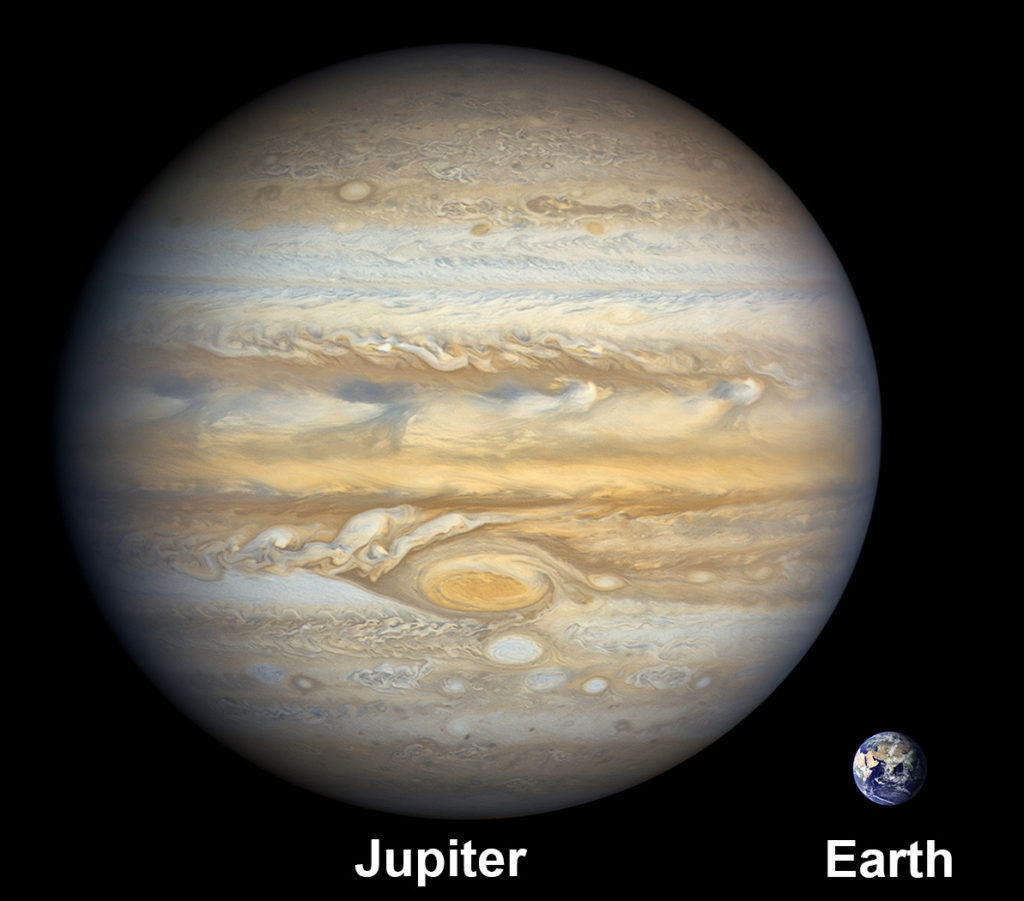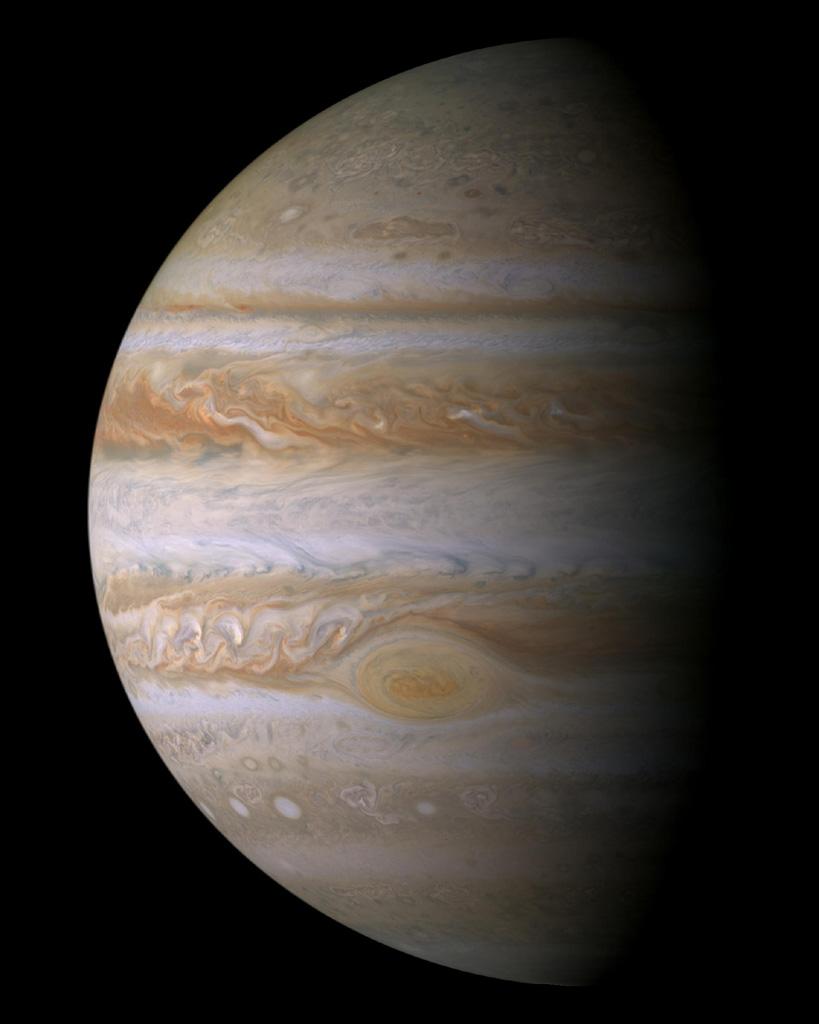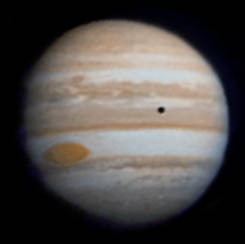The planets we have explored previously in this series are terrestrial: earth-like. They are solid, rocky masses, orbiting relatively close to the sun. Images taken by landers show a surface that is much like earth except for a total lack of plants and animals. The outer planets of the solar system are very different. They are much larger than the terrestrial worlds, and are made of gas, lacking a solid surface. And so we begin our exploration of the gas giants with Jupiter.
Jupiter is the largest planet in the solar system – over ten times the size of Earth in diameter. Like the sun, it is an enormous ball of hydrogen and helium gas with smaller amounts of other elements held together by its own gravity. Although hydrogen and helium are the two lightest elements, Jupiter has so much of them that its mass is greater than the rest of the planets combined, and yet is only 0.1% the mass of the sun. The pressure of the gases increases as we dive deeper into Jupiter, and at some point, they are forced into a liquid state. But Jupiter has no solid surface.

Orbit and Rotation
The terrestrial planets orbit relatively close to the sun and to each other. But there is a substantial gap between the orbits of the fourth planet (Mars) and the fifth planet (Jupiter). Jupiter orbits at 5.2 AU, or 5.2 times the average distance from Earth to the sun.[1] At such a distance, Jupiter takes 11.86 years to orbit the sun once. As such, as viewed from Earth, Jupiter reaches opposition every 13 months. Like all the outer planets except Mars, Jupiter is well-placed for viewing in a backyard telescope for roughly 6 months out of every year.
Jupiter has the fastest rotation of any planet in the solar system, rotating once in only 9 hours, 56 minutes. For something so large to rotate so quickly is impressive and causes the equator to noticeably bulge. Hence, the diameter of Jupiter from north to south pole is 83,000 miles, but the diameter across the equator is 88,900 miles – a substantial difference that is noticeable in a small telescope. Hence the shape of Jupiter is an oblate spheroid – essentially a sphere that has been compressed in one dimension.[2] Since Jupiter is not solid, it rotates differentially. That is, some latitudes rotate faster than others. The stated rotation is usually given as an average, or is based on the rotation of Jupiter’s magnetic field.
Physical Characteristics
Since Jupiter orbits the sun at a great distance, the sun would appear 27 times fainter than it does from Earth. Consequently, the temperature of Jupiter’s clouds would be around 234 degrees below zero (Fahrenheit). Temperatures of the terrestrial planets are normally given at the surface, but the outer planets lack a solid surface.[3] The temperature increases substantially as we explore deeper into Jupiter, possibly reaching 43,000 degrees Fahrenheit at the core. Such energy is constantly drifting away from the core into the upper layers, and eventually radiated away into space. Jupiter actually gives off twice as much heat as it receives from the sun.
This internal heat is puzzling to secularists, and seems to be a confirmation of the biblical timescale. There is nothing in Jupiter that could generate energy in the core since the temperature and pressure falls far short of what is needed for nuclear fusion, and Jupiter lacks the heavy elements that could generate heat by radioactive decay. Nor can gravitational collapse explain such heat since Jupiter’s interior is incompressible liquid. Hence, the planet has been constantly leaking its energy into space since creation. And if it were billions of years old, it should have exhausted its energy supply a long time ago. This is a common characteristic of the outer planets.[4]
Jupiter has an extremely powerful magnetic field, about 2000 times stronger than that of Earth. When solar radiation interacts with the magnetic field, it generates spectacular aurora which have been imaged by the Hubble Space Telescope. Since magnetic fields naturally decay with time, if Jupiter were billions of years old as secularists claim, it is difficult to imagine how such a field could be sustained. Although dynamo models have been proposed to recharge the magnetic field, there just isn’t good evidence of such a mechanism on Jupiter.
The composition of Jupiter is similar to that of the sun – mostly hydrogen and helium gas. But since the outer layers of Jupiter are much colder than the sun, the trace elements can form compounds. These include ammonia, methane, and water vapor. These compounds give rise to the wonderful and colorful cloud features seen on Jupiter. The internal heat of Jupiter drives convection currents in its atmosphere, creating patterns in the clouds, and driving storms.
The most obvious feature of the clouds of Jupiter is that they are stretched into horizontal stripes across the visible disk. The orange stripes are called “belts” and the white stripes are called “zones.” The belts are physically lower in the atmosphere than the zones. So, when you look at a belt, you are looking deeper into Jupiter than when you look at a zone. The zones are cirrus clouds comprised mainly of ammonia crystals. Belts and zones mark the boundaries where the prevailing winds switch directions (see the figure below). This is just like the latitude dependence of prevailing winds on Earth. But the Earth has only three cells in a given hemisphere, and they are not easily seen since Earth’s atmosphere is largely transparent.

Jupiter normally has six main belts, interspersed between seven main zones. Since there are no landmasses on Jupiter to disrupt the jet streams, the belts and zones of Jupiter are remarkably stable. The two equatorial belts and the equatorial zone are easily seen in even a very modest backyard telescope. Astronomers have been observing them for centuries. Belts and zones at higher latitudes are thinner and more difficult to see in a backyard telescope.
The South Equatorial Belt is remarkably active. It is occasionally split by a narrow zone. And roughly once or twice in a decade, the South Equatorial Belt disappears entirely for several months as white clouds conceal the lower layers. This has happened 17 times since 1901 and last happened in 2010. The North Equatorial Belt is eerily permanent.
The Great Red Spot
One of the most distinctive and well-known features on Jupiter is the Great Red Spot (GRS). It is high-pressure storm, an anticyclone roughly two Earths in length. It is the largest storm in the solar system and has been observed continuously since 1830. Hurricanes on Earth are powered by the heat of the ocean. When a hurricane moves over land, it is cut off from its power source and gradually dissipates. But on Jupiter, there is no land. So storms on Jupiter are remarkably long-lasting. The GRS may even be permanent.

The Great Red Spot is located at a latitude 22 degrees south of Jupiter’s equator. It is lodged between the South Equatorial Belt and the South Temperate Zone. The shear between two consecutive jet streams prevents the spot from moving significantly north or south, and causes it to rotate counterclockwise with a period of about six (Earth) days. The precise cause of the red color of the spot is currently unknown. Although the GRS cannot move north or south, it does drift to the west or the east in a slow but unpredictable way. For this reason, tables that predict when the red spot will transit (cross the central meridian of Jupiter from our perspective on Earth) are only accurate for a few months.
There are many smaller storms on Jupiter. So, the GRS is merely the largest and apparently most stable of Jupiter’s many storm systems. Also prominent in the southern hemisphere are six to nine white ovals called the “String of Pearls.” Like the GRS, these are counter-clockwise rotating anti-cyclones. They are significantly south of the GRS at a latitude of -40 degrees. A few other white ovals are found at other latitudes. In addition to these relatively permanent storms, Jupiter also occasionally has transient storms appearing in either hemisphere. These sometimes appear as a dark feature, and the larger ones are visible in a modest backyard telescope.
Although the existence of the Great Red Spot appears to be relatively permanent, its size, shape, and color change over time. In the early 1970s the Red Spot was particularly prominent and large. The storm was nearly three earth diameters across at the time. During the Pioneer 10 flyby in December 1973, the South Equatorial Belt had all but disappeared, and so the contrast between the GRS and the white ammonia clouds surrounding it was spectacular. This condition was still present during Pioneer 11’s flyby one year later.

Voyager 1 flew past Jupiter in March 1979, and Voyager 2 followed up four months later. Images from the Voyagers show a slightly smaller version of the storm than those imaged by the Pioneers. Furthermore, the South Equatorial Belt was prominent at the time. And the distortion in the belt produced by the storm was very obvious. These were the sharpest images of Jupiter available at the time, and dominated the textbooks during the 1980s.
In the late 1980s, the GRS had faded to a much lighter red making it very difficult to see in a backyard telescope. In fact, the large indentation produced in the South Equatorial Belt was often the only visible evidence that the GRS still existed. The Galileo spacecraft orbited Jupiter and transmitted images 1995 to 2003. Fortunately, the GRS had returned to its normal hue by this time. By 2004 and thereafter, images of the GRS from the Hubble Space Telescope show that the spot is considerably smaller and rounder than it has been at any time in the past century. However, the color seems to have deepened recently, which should make telescopic observations much more rewarding.

How old is the GRS? We know it is at least 190 years old, since we have observations going back to 1830. But Giovanni Cassini documented a great dark spot in Jupiter’s southern hemisphere in 1665. He noted that the spot was apparently permanent and rotated along with Jupiter. This spot was observed by various astronomers until 1713. So perhaps, the GRS is at least 355 years old.
But no one observed a great dark spot on Jupiter for over a century – between 1713 and 1830. So we can’t be sure that the GRS is the same storm observed by Cassini. In fact, the early observations did not describe the spot as being red in color, but merely dark. Then again, the GRS does change in color. So, is it the same spot? Did the GRS change color (as we know it does even today) to near-white, making it essentially invisible for a century? Or did one storm dissipate followed by different storm that formed a century later? We may never know.
The Rings of Jupiter
When we think of a planet with rings, we almost immediately think of Saturn. But Jupiter also has a system of rings consisting of dust and small particles that orbit around Jupiter’s equator. However, the density of these rings is far less than the spectacular rings of Saturn. Consequently, Jupiter’s rings are essentially transparent and not easily observed. They were discovered in 1979 by the Voyager 1 spacecraft. When Voyager 1 passed behind Jupiter into its shadow, the much fainter sunlight reflecting off the thin rings became visible. The more recent Galileo spacecraft also imaged these rings as seen from behind the planet. With modern technology, it is now possible to detect these rings from Earth, but this requires the very largest ground-based telescopes or the Hubble Space Telescope.

Observing Jupiter
There’s no missing Jupiter. It is one of the brightest objects in our night sky, surpassed only by the moon and Venus, and occasionally by Mars.[5] Jupiter appears as a bright white star with no substantial coloration. It is very pretty to the unaided eye. But viewing Jupiter through a small telescope is the real treat.
Even a very modest backyard telescope will readily reveal the two equatorial belts of Jupiter, and the zones surrounding them. Seeing the other, thinner belts may require a larger telescope, and nights where the air is particularly calm. The belts are noticeably orange in color. You can enhance the contrast between the belts and zones using a blue or green color filter. Jupiter is tilted only 1 degree relative to its orbit about the sun, which is very nearly in the same plane as Earth’s orbit. So, we always see Jupiter with its equator nearly edge-on. For this reason, the belts and zones always appear as straight line-segments in the eyepiece of a telescope.
You may notice subtle variations in the belts and zones, and the occasional transient storm. Due to Jupiter’s rapid rotation, any features on its disk will shift from left to right as the evening progresses.[6] You will also notice that Jupiter is not quite round. As mentioned above, the rapid rotation causes the equator to bulge, and is noticeable even in a modest telescope.
It is particularly fun to look for the Great Red Spot, but it is not always easy to find. For one thing, since Jupiter rotates, the GRS spends 50% of the time on the far side of Jupiter. You might think that if you observe Jupiter at a random time, you would then have a 50% chance of seeing the GRS. But that is not so. Jupiter doesn’t look nearly as crisp in a backyard telescope as it does with the Hubble Space Telescope, or as imaged by the many spacecraft that have visited the planet. Consequently, if the Great Red Spot is very close to the limb of the disk, the slight blurring effect of Earth’s atmosphere combined with the optics of the telescope make it nearly impossible to see.
The GRS is best observed when it transits – when it is nearest to the center of the disk. Fortunately, due to Jupiter’s rapid rotation, this happens every ten hours. If you stay up observing Jupiter all night, it will happen at least once, and possibly twice! But you don’t need to guess. You can look up Jupiter’s Red Spot transit times in an online table. These often give the time of transit in “U.T” (universal time) which is the time at Greenwich, England. For those of us in the United States, this is several hours ahead of our local time. So, you must subtract a certain number of hours depending on your time zone. For Eastern Standard Time, you subtract 5 hours, and for Eastern Daylight Saving Time, you subtract 4 hours. Some internet apps automatically make this adjustment. Perhaps as interesting as observing the planet Jupiter in a telescope, is observing its moons. Jupiter has four large moons, and these are visible in even a very modest telescope. You can watch them switch positions night after night as they orbit Jupiter. On occasion, one or two of the four will be directly in front of or behind Jupiter, rendering it invisible. But most often, you can see all four. Sometimes a moon will cast its shadow on Jupiter, appearing as a black, very sharp circle. These moons are some of the most fascinating worlds of creation. And we will discuss them in our next Worlds of Creation article.
[1] The unit “AU” stands for “astronomical unit” and defined to be the average distance between the Earth and the sun, about 93 million miles.
[2] The Earth is also an oblate spheroid for the same reason. But the difference between the polar and equatorial diameters of Earth is not easily noticeable to the unaided eye.
[3] Some literature lists the “surface temperature” of Jupiter by defining the surface as the altitude at which the atmospheric pressure is equal to one bar – the pressure of Earth’s atmosphere at sea level.
[4] The planet Uranus is the one exception. It lacks the internal heat of Jupiter, Saturn, and Neptune.
[5] Mars only outshines Jupiter for a short period of time every 2.1 years. The rest of the time, Jupiter is much brighter. In principle, the planet Mercury can reach an apparent brightness that exceeds that of Jupiter, but only when Mercury is in conjunction and therefore not visible.
[6] The left-to-right motion is the true rotation of Jupiter as viewed from Earth’s northern hemisphere. The image of Jupiter may appear reversed in the eyepiece, depending on the configuration of the telescope.

